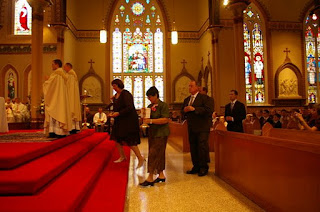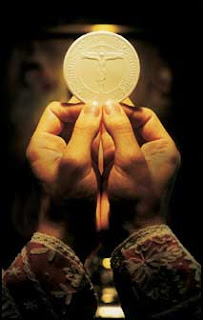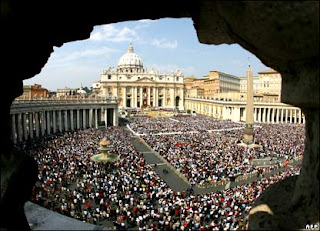Some of our students who weren’t able to make it to Mass last evening were upset they missed our “teaching Mass” where we introduced the new English Translation of the Mass, and explained some of the changes and other parts of the Mass that perhaps they had forgotten / never heard before.
Just a “warning” – these are my “notes” – so I didn’t write them to be published, so please excuse grammatical/spelling mistakes (which regularly appear even when I do know I’m going to post something!) Also – please know that I used a couple of sources for a great deal of these notes — Dr. Edward Sri’s “Biblical walk through of Mass” and the Magnificat Roman Missal companion; as well as things I remembered from liturgy classes in Seminary… So here we go…
INTRODUCTION:
Today we start using a new English translation of “THE ROMAN MISSAL” which is the book that contains all the prayers and responses for our worship.
One of the beautiful things about our Catholic-Christian faith is the Unity of the Universal Church. For centuries the language at Mass was Latin. A major reason for that was to maintain our unity – that no matter where you went to Mass around the world, Catholics would all be saying the same thing.
In the 1960’s the Church recognizing how fewer and fewer understood Latin and prayerful concluded that we could still say the same thing but allow the Mass to be celebrated in the language of the people.
So we’ve only been celebrating Mass in English (or any other language other than Latin) for close to 50 years (and the Catholic faith has been around for over 20 centuries!) The Church, constantly is prayerfully considering where we are and where we believe the Holy Spirit is moving us to go. In recent years, Bishops (especially those who speak multiple languages) noted that the English translation wasn’t nearly as precise as the other languages to the original Latin texts we used. And that in some cases the meanings and scriptural references were a bit lost or missed. Not to mention that not all English Speaking peoples were using the same translations of the prayers. That’s why we have a new translation.
So tonight at this Mass, as we introduce the new translation with some of the changes that will affect the responses that we’re used to making, we’re going to have what’s called a “teaching Mass” where I’ll try to pause at certain points and explain what it is we’re doing and WHY we’re doing it (in some cases in a new way):
As Catholics the first thing we do at Mass after we’ve Gathered is to begin our worship recognizing that God is a God in three persons. The gesture of the sign of the Cross has ancient origins with written descriptions of it being done before the year 200. In making that sign, we invoke God’s presence and invite him to bless us, assist us and guard us.
Immediately after the sign of the Cross, in the words of Greeting we discover the first change: There’s three possible greetings the priest can use and all of them have origins from both the Old and New Testaments.
The most common has been “The Lord be With You”. When the priest is saying that it’s not a Church way of saying “hey how are you” and the people responding back “great and you?” The Priest is reminding the people that when we assemble in Jesus’ name – as he told us in the Gospel of Matthew – that He is here in our midst. So whenever we hear “The Lord be with you” it’s a reminder that we make this space Holy and that sacred things are taking place in our midst.
Here is one of the first changes for the people. So as your priest, I’m calling on you to remember this important aspect that you by gathering in Christ’s name make him present, From now on in response to that , you will respond“And with your Spirit.” Again, this comes right from scripture from St. Paul’s letter to the Galatians. By saying “And with your Spirit” it’s not exalting the person individually (me Fr. Jim) – it’s the community, who recognizes that “The Lord is with Them” and in response recognizes the deepest interior part of the priest – His Spirit, that has been transformed by ordination, that allows him, that makes him able to lead the people in these most sacred actions of the Church – The Celebration of the Mass.
 END OF INTRO RITES/ BEFORE READINGS:
END OF INTRO RITES/ BEFORE READINGS:
With the conclusion of that Opening Prayer, which we call “the Collect” which says what it means – it “collects” all the prayers and intentions of the people gathered to participate in the Mass – we have concluded what is called “the Introductory Rites”. Now we begin what is called “The Liturgy of the Word”
This is considered the “first table” of “two tables” in which God’s people are nourished. So in this First Table – we are fed with God’s Sacred Word coming from scripture. It’s good for us to remember that the scriptures aren’t just moral lessons, reflections on the spiritual life or historical recollections. We believe that in the Liturgy of the Word – God is speaking to us. Yes, through human authors and their writing styles, and historical incidents are recounted, but the fact that are contained in scripture means they are inspired by God. And so we are about to hear God speaking to us.
This being the first Sunday of Advent, we begin a “New Church Year”- On the First Sunday of Advent, we start reading from a different Gospel. Last week we finished reading the Gospel of Matthew, now we begin the Gospel of Mark. Next year on the First Sunday of Advent we will hear from the Gospel of Luke. In the course of three years in coming to Mass, you would hear the entirety of the Gospels proclaimed (with the Gospel of John being heard throughout the Easter Season as well as parts of the seasons of Advent, Christmas and Lent and when Liturgically appropriate)
Our First Reading usually comes from the Old Testament. At the end of the passage, the lector says “The Word of the Lord” – That’s not our way of saying “The End of this, let’s move onto the next thing” – it should cause us to pause in amazement how marvelous it is for us human beings to hear God speaking to us… Which is why we respond with a heartfelt “THANKS BE TO GOD”
Between our First and Second Reading – we respond not with our own meager words but rather with God’s own inspired words of praise and thanksgiving from the book of Psalms – a collection of poetry that captures the spectrum of Human emotions and experiences and the presence and activity of our God through all of them.
Our Second Reading comes from the New Testament, usually one of the letters written by St. Paul, St. Peter, St. James, St. John to the Early Church communities. While the first reading is often connected to the Gospel, the Second Reading is meant to reflect on the mystery of Jesus Christ and his saving work – and the meaning it has on our lives.
BEFORE THE GOSPEL:
So while the whole Bible is the inspired word of God – The Gospels hold a special place because they are the “principle source for the life and teaching of the Incarnate Word, our Savior” JESUS CHRIST.
That’s why we do some things to point out the special reverence for hearing the Gospel – we STAND to welcome the Lord Jesus who is about to be proclaimed. We SING “ALLELUIA” – a Hebrew word which is so particular that we cannot fully find an English translation. The closest we can come is “Praise the Lord” – But it’s a word we find in scriptures that captured the angels using that word to praise God for his work of salvation and to announce the coming of Jesus Christ to his people.
The Priest carry’s the Book of the Gospels – again to underscore the solemnity and importance of about to happen. (You might notice that the priest bows at the altar and seems to mumble to himself, the priest is praying: Cleanse my heart and my lips, almighty God that I may worthily proclaim your holy Gospel. AGAIN – this comes from scripture, where the prophet Isaiah’s lips needed to be purified before proclaiming the word of the Lord to Israel).
The priest reminds the community again “THE LORD BE WITH YOU” and the community reminds the priest of his special role, now speaking the words of Chirst “AND WITH YOUR SPIRIT” – at which point we trace the Sign of the Cross on our head, lips and heart – which is our way of consecrating our thoughts words and actions to the Lord asking that his Word in the Gospel be always on our minds, our lips and in our heart.
HOMILY:
From the earliest days of Christian liturgy, the Word of God was not read on its own – It was accompanied by a homily which explained the meaning of the scriptures and drew out applications for people’s lives – this was an ancient Jewish custom that continued through Christianity to this day.
There’s a reason that only a priest or a deacon preaches a homily. We believe that the Bishops are the successor of the apostles – the priests and deacons are sharers of that authority (the Archbishop could remove my “faculty” to preach and in fact has the responsibility to if I should be leading the people of God astray) And the idea of this is that the scriptures are to be read and understood under the authority of the apostolic faith. That’s why only an ordained minister can preach a homily. That’s not to say that lay people or a religious sister of brother might be more eloquent than a priest, but the homily in the context of the Mass, preached by an ordained minister is meant to be a guarantee that the preaching is passing on the Church’s apostolic faith – not just the private thoughts or experiences of any individual person.
CREED:
As the Liturgy of the Word comes to a conclusion, we come to the Creed which is an ancient statement of our faith. In a sense, we give a cliffs notes narrative to the entire Scripture from the creation of the world, the Fall of humanity, the incarnation (or coming of Christ) – His Death and resurrection to the sending of the Holy Spirit, the era of the Church and looking forward to the Second Coming.
There’s a few noticeable changes which is why we need the cards to assist us in our proclamation of something that many of us had memorized:
First is the shift of the very first word from “WE” to “I” believe – starting with “I believe” is an exact translation of the Latin word “credo” and the difference is that while we are baptized into a community of believers, we acknowledge that we receive the sacrament in our own persons, one by one – that we have a personal relationship with the Lord Jesus Christ and with His Church. So by saying “I believe” I’m making a declaration of what I believe with my heart, my mind, my soul…
There’s a few other changes of significance – and because this is such an important “statement of faith” that we are making, it’s important to notice the changes and what they mean:
things visible and invisible instead of Seen and unseen – the emphasis is that it’s not just a matter of perception, but things by there very nature cannot be seen – angels for one; the “moral law” for another – all have their origin in God and are a part of His creation
only Begotten Son of God, born of the Father before all ages – while we celebrate at Christmas Jesus being born into humanity, into time, this is a more precise theological point that before there was a thing called “time” – God existed and that there was never the Father without the Son and the Holy Spirit. All things, all times – from the beginning of the world to its eventual end are a creation of the Blessed Trinity.
The next change has probably gotten the most attention: from “one in being with the Father” to Consubstantial with the Father – this, again, is a more precise explanation that Christ is not a different God or somehow less significant than the Father. The Father, Son and Holy Spirit are of the same substance, so since God is one, Christ being consubstantial with the Father means he too is God – not a different God, but the same God.
Incarnate of the Virgin Mary – rather than saying “born of the Virgin Mary” which turns our minds to Christmas at Jesus’ actual birth, by being more exact and saying “incarnate” we recall the Annunciation – the moment where Mary said to the Angel “behold I am the handmaid of the Lord, May it be done to me according to your word.” Jesus became incarnate in the virgin Mary 9 months before his birth.
The Prayer of the Faithful –
The final act or the culmination of the Liturgy of the Word is what we call “THE PRAYER OF THE FAITHFUL” – This has been a part of the Mass from ancient times, as late as the year 155. In a letter written by St. Justin the Martyr where he gave an outline of the prayers and rituals of Mass, he explained that after the readings from scripture and homily – [QUOTE] we all rise together and offer prayers for ourselves… and for all others, wherever they may be, so that we may be found righteous by our life and actions, and faithful to the commandments, so as to obtain eternal salvation.”
 – Before the Preparation of the Gifts-
– Before the Preparation of the Gifts-
We’ve now concluded the Liturgy of the Word – now we enter into what is called the LITURGY OF THE EUCHARIST where Jesus’ sacrifice on the cross is made present by the priest – by carrying out what Jesus did at the Last Supper and what he commanded the apostles to do in his memory. The people bring forward bread and wine as gifts which are consecrated and changed into the body and blood of Christ.
During the Preparation of the Gifts, on Sunday, usually we sing a hymn so often times you don’t hear the prayers the priest offers as bread and wine are presented to him. Bread and wine had profound meaning to the Israelites – Bread was the most basic food and necessary to sustain life; wine was not just a side beverage, but a common part of Israelites meals. At the most ancient of Israelite meals, the Passover feast – which was what the Last Supper was – Jesus offered the bread and wine as the priests do today acknowledging that these offerings are gifts of His creation and the result of our labors. This rite symbolizes our giving of our entire lives to God in the offering of bread and wine.
THE EUCHARISTIC PRAYER:
With the prayer over the gifts concluded we now begin “The Eucharistic Prayer” – which from this point till we sing the Great AMEN is one long prayer that consecrates the Bread and Wine into the Body and Blood of Christ.
Because of the importance of this, there’s again a great deal of meaning to the things we do at Mass.
The first thing is once again the invocation of “The Lord be with You” – as we said earlier, this was a biblical greeting that when God called people to important but daunting missions they were greeted with these words because they needed the Lord to be with them as they set out on their charge – here this greeting is repeated as we embark on the most sacred part of the Mass. You’re response to the priest is a reminder that this isn’t something the priest himself does, it is the work of the Holy Spirit who has transformed the priest’s soul, his spirit at his ordination.
Then the priest says “Lift up your hearts” – another exhortation that comes right from scripture. In the bible, the heart is the hidden core of a person – their thoughts, emotions, actions all are contained in the heart. So in lifting up our hearts, the priest is calling us to bring our fullest attention to what is about to unfold. Which is why we respond “we lift them up to the Lord” – recognizing this is the only place we should be focusing our attention.
Finally (and another Change) is when the Priest says “LET US GIVE THANKS TO THE LORD OUR GOD” We now simply say “it is right and just.” This brief translation corresponds to the Latin version. We affirm simply that it is the right, and just thing for us to do.
THE COMMUNION RITE:
Before the Our Father:
Now we begin the final preparations. The Eucharistic Prayer is ended and we begin “The Communion Rite” – the bread and wine have been consecrated and Jesus is now truly present before us – in a few moments we will receive his body and blood in holy communion. From this point forward these rites are meant to lead all of us to the sacred point of holy communion and help ensure we are properly prepared to receive the body and blood of Christ.
First is the Our Father which our Lord and Savior Jesus Christ did not simply give us words to pray – He gave his saving command to pray these words which also forms us as Children of God.
Now we participate in THE RITE OF PEACEIn the Our Father we asked the Father for deliverance from evil and for peace to be established. Now the priest addresses the Lord Jesus recalling his words from the Last Supper where He offered us that deep, longer lasting peace that the world does not give.
We are reminded that in this rite that when Jesus is the foundation of our lives, when we follow his commands, we can withstand life’s many disappointments, trials and sufferings – This is the peace that builds unity between a husband and wife in marriage; in families, in communities and nations. Which is why the priest now shares the words of exhoratation from St. Paul “THE PEACE OF THE LORD BE WITH YOU ALWAYS” and once again you respond that that peace reign in the core of the priest – and with your spirit. Then we exchange a sign of peace. A sign that signifies that we who have called God “Our Father” are brothers and sisters and as apart of that family are called to live in peace with one another – and it challenges us to work to make God’s peace a reality in our love and forgiveness to one another.
AFTER LAMB OF GOD/BEFORE INVITATION:
The words “Lamb of God” takes us right up to God’s throne. When we say or sing those words, we join the angels who worship Jesus as the victorious Lamb in the New Testament book of Revelation. So we are crying out with our hearts that this Lamb of God has saved us from our sins by his death and resurrection.
The change to the “invitation to communion” now has the Priest inviting us to “BEHOLD THE LAMB OF GOD” – which comes from the Gospel of John. These are the words of John the Baptist who when he saw Jesus in the Jordan, he cried out with those same words. So we are being invited to “BEHOLD” to contemplate the mystery, to gaze upon and behold with heartfelt gratitude what God has done for us.
After that is a signifigant change in translation that uncovers a scriptural reference most of us never noticed before. In the Gospel of Matthew & Luke, there’s an encounter that Jesus has with a Roman Centurion who has a servant who is seriously ill. The Centurion says to Jesus “Lord I am not worthy that you should enter under my roof, but only say the word and my servant will be healed.” With the change in the translation we are recapturing that biblical scene and personalizing the words.
Jesus was willing to go to the home of that centurion to heal that servant, but the centurion with all humility felt unworthy, uneasy, that Jesus should come into his house and even more had the faith that Jesus only had to “say the word” and his servant will be healed. We know that Jesus wants to come into our “roofs” – into our body’s and souls as we receive His Body and Blood, soul and divinity in this Eucharist, to heal us and transform us. We pray for that faith of that centurion believing that this is possible.
CONCLUDING RITE:
One final time, the priest reminds the people that the Lord is with them (and the people remind the Priest that all that he has just lead them in and this final act is an act of the priesthood, not him personally as they say and with your spirit) and there’s a simpler dismissal “Go Forth, the Mass is ended”
The word Mass in fact means “sending” – we who have celebrated the Eucharist are called to go forth and fulfill God’s will in our daily lives, recalling Jesus’ words at the end of the Gospel of John “As the Father sent me, even so I send you.”
We are called to radiate his life and his love in the world – we are to bring for the mysteries of Christ into the darkness of the world around us.



















As the mother of a priest, I love what you have said. I wish we ( the layity) were given this explination before Advent.
A thoughtful and insiteful piece.
As the Mother of a priest, I have never read a more insiteful analogy of the "New Mass".
Your instruction was ever so gentle ,but, thought provoking, and simple to the Nth degree.
I wish that your understanding would have been given to us (layity) in the middle of October 2011 so that the faithful could more completely understand the changes.
Thank you.
May God grant you peacae.